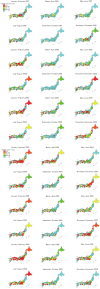Monthly observation of the number of patients with Kawasaki disease and its incidence rates in Japan: chronological and geographical observation from nationwide surveys
- PMID: 19075496
- PMCID: PMC4771612
- DOI: 10.2188/jea.je2008030
Monthly observation of the number of patients with Kawasaki disease and its incidence rates in Japan: chronological and geographical observation from nationwide surveys
Abstract
Background: Although the epidemiologic features of Kawasaki disease for Japan have been observed, recently, chronological and geographical observations of the number of patients and incidence rate of the disease have not been conducted using observation units smaller than the whole country.
Methods: We used the recent 5 nationwide surveys (the 15th to 19th) of Kawasaki disease in Japan, which covered patients for 10 years, i.e., between 1997 and 2006. The monthly number of patients by prefecture was calculated, and the number was corrected by the response rate of the target institutes of the prefecture. Chronological changes in the number of patients were observed by district. Geographical changes in the incidence rates were observed bimonthly by prefecture for the recent 6 years, from 2001 through 2006.
Results: On the whole, the monthly number of patients increased gradually. For each year, the number was the highest in January and the lowest in October; it was relatively high during summer as well. Some differences existed among the districts with regard to the monthly observations. Bimonthly observations of the incidence rate by prefecture revealed the differences in the characteristics of the epidemics in different geographic areas.
Conclusion: The chronological and geographical changes in the occurrence of Kawasaki disease in Japan for the recent 10 years suggested the involvement of one or more infectious agents in the occurrence of the disease.
Figures




References
-
- Shigematus I. Significance and future problems of epidemiologic studies on Kawasaki disease. In: Yanagawa H, Nakamura Y, Yashiro M, Kawasaki T, editors. Epidemiology of Kawasaki disease: a 30-year achievement. Tokyo: Shindan-to-Chiryosha; 2004.
Publication types
MeSH terms
LinkOut - more resources
Full Text Sources
Other Literature Sources
Medical

